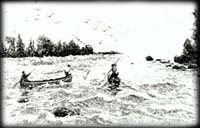|
|
Primarily, the rapids were a natural habitat for whitefish, which became a vital component in the dietary and economic life of the settlement. Bawating, as the site came to be called, was primarily a fishing village but quickly assumed social, cultural and economic significance as a meeting place for various tribes of the Algonkian nation. Defence alliances and trade relationships were negotiated at the annual gatherings, when the village would grow from 200 to 2000 inhabitants.
The Hudson's Bay Company, the Northwest Company and the American Fur Company exploited the area for its fur trade by establishing posts in the area. Charles Oakes Ermatinger, initially an independent fur trader, established his residence here, which remains to this day. The construction of a canal and lock in 1895 to bypass the rapids provided an all-Canadian route from the Atlantic Ocean to the head of Lake Superior. In 1887 the Canadian Pacific Railway constructed a spur line linking Sault Ste. Marie with the main CPR line in Sudbury. The construction of a bascule bridge joining the CPR with railroads in the United States made Sault Ste. Marie a popular and well used junction, linking Canada with the markets of the vast hinterland of the American midwest. The industrial empire created by Francis Hector Clergue spurred local development in the late 1890's and early 1900's. Directly, or indirectly, he created pulp and paper mills, hydro-electric plants, rail and marine transportation, mines and a steel plant, thereby increasing the physical size and population of the community. The success, growth and economic well-being of Sault Ste. Marie can be tied directly to the progress of local industry, including Algoma Steel Inc. and St. Mary's Paper. Tourism, once a small adjunct to the financial well being of the community, has become one of the largest and most lucrative of local industries. The Agawa Canyon Tour, the Ontario Winter Carnival Bon Soo, and the excellent hunting and fishing opportunities lure thousands to the area yearly.
This area, virtually the first settled community northwest of Quebec, has been the hub, around which various cultural, ethnic, religious, political, industrial and historical wheels have rotated. Here is a small microcosm of Canadian life, constructed and run by Canadians during several important eras, and different than our neighbours to the South. One can trace the history of a community through the prism of its heritage buildings and sites. These Heritage sites revitalize, stabilize and enhance the character of a community, while they preserve significant design and artistry aspects. They represent the culture and very soul of a community's history. Visitors to this site will see how these Heritage sites can be used to interpret the communities' story. The side by side comparison of old and new allow viewers to contrast historical uses to present day uses. |





